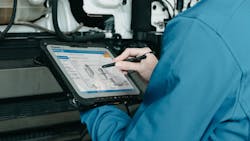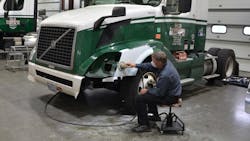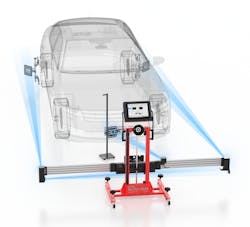Technicians need to be able to service every commercial vehicle that rolls into the shop, and that has become an increasingly tougher task as fleets add more sophisticated models and a wider range of powertrains. It won’t be long before a seasoned diagnostic tech might have to find the source of a dual stage SCR fault in the morning and then troubleshoot a fuel-cell truck’s electrical system after lunch.
OK, maybe that latter one will be at least a few years off, as the first fuel-cell electric trucks just went into production at Nikola’s Arizona plant, but the latest International trucks spec’d with the S-13 integrated powertrain already have those dual-stage SCRs. The point is the complexity of commercial vehicles is accelerating so fast that current aftertreatment issues may seem quaint by the end of the decade.
Fortunately, as these modern vehicle systems and components advance, so do the industry’s arsenal of diagnostic tools. Along with a healthy amount of training and experience, these tools will help CV technicians not only take on any task but also increase their speed and accuracy on a wide range of repairs. That, in turn, will allow shops to improve their throughput and drive more sales. In short, the right diagnostic tools may turn this time of unprecedented transition into an era of limitless opportunity.
“The key to increasing your profit margins is providing your technicians with the diagnostic coverage able to connect to new vehicle models as well as new vehicle system types that are coming to your shop,” said Daniel Bemiss, senior marketing manager for Texa USA.
See also: Don't distress; de-stress your diagnostic process
Expanding diagnostic capabilities
One way to increase profits is by ensuring that your diagnostic solution can resolve more than one duty cycle’s DTCs.
“HD repair shops that can service construction and agriculture equipment—or even industrial and power sports vehicles—have the ability to grow their business,” Bemiss said. “Customers will appreciate all that repair ability at a single location service and will repeat with more business.”
Jason Hedman, product manager at Noregon, said the supplier’s heavy-duty diagnostic solution JPRO has improved its off-highway coverage so that the same tool can diagnose fleets’ off-highway equipment and on-highway vehicles in a single application.
Hedman added that there are also opportunities for shops to provide new services as all equipment gets smarter.
“As trailers are becoming more advanced, there is a need to diagnose them accordingly,” he said. “Many fleets are seeking guidance on diagnosing these smart trailers and which software to use.”
Safety technology is another lucrative revenue stream. Advanced driver assistance systems (ADAS)—such as lane-keeping assist, blind spot detection, and collision mitigation—use a variety of finely tuned sensors, all of which require calibration after collisions or certain repairs.
“One of the largest opportunities for shop owners today is offering ADAS calibrations after an alignment, which is required by most OEMs,” said Stewart Peregrine, sr. executive of sales, ADAS, Autel North America.
Victor Rivilla, marketing director for CanDo International, said he is receiving more requests for commercial tire pressure monitoring systems, and also that more discussions around electric vehicle needs are taking place.
“To that end, we are working with OEs in both [TPMS and EV sectors] to make sure we have the coverage necessary even before it is needed,” he said.
Increasing Efficiency
Today’s tools make it easier for technicians to diagnose problems, even if they have not worked on the make or model before.
“There is so much more on the vehicle, and the scan tools have changed,” Peregrine said. “Today’s tools are so much better than they were ten years ago, and that includes whether it was the factory tool or the aftermarket tool.”
Not only are diagnostic tools better and more essential than ever, they appear to be more available. According to Noregon’s Unpacking the Commercial Vehicle Diagnostic Market 2023 report, in less than three years, on average there will be one diagnostic tool for every two technicians in the shop. Two years ago, it was tne tool for every four techs.
The reason for their proliferation is simple: They make hard repair jobs easier. Diagnostic tools often walk technicians through complex repairs step by step. That increases technician productivity, maximizes their output, and allows them and the shop to earn more money.
“These diagnostic tools are like turbochargers for work speed—they dish out quick and precise insights into what’s up with a vehicle,” said Miguel Moneo, sales manager, Jaltest Diagnostics, Cojali USA. “This cuts down the time techs would otherwise spend manually hunting down problems. As a result, more vehicles are diagnosed and fixed in the same time window.”
However, tools must be user-friendly to be effective.
“Technicians understand that vehicles today are saturated with electronics,” said Homer Hogg, VP of truck service for TravelCenters of America. “They tend to look for effective and logical electronic formats built into diagnostic equipment.”
Cumbersome and unorganized graphical interfaces tend to frustrate technicians and can cause them to look for better solutions, which can hurt productivity and increase turnover, Hogg said. Fortunately, providers are working to improve the navigational steps and graphical interfaces to improve the technician’s experience.
Diagnostic tools are becoming hubs where technicians can get codes, lookup components, determine operating specs, and access troubleshooting steps.
“Trucks get more and more complex, running up to 40 computers in one vehicle. With that, having the code is just the starting point. Technicians need information and access to data in order to be able to repair,” Moneo said, adding that Jaltest details necessary repairs, repair times, and indispensable components. “As a result, technicians can adeptly strategize their repair processes, ensuring the availability of precise parts and tools.”
CanDo’s HD Pro III offers CAN Node Screening where all modules on the CAN line can be accessed for codes, live data, and deeper diagnostic functions. CanDo has also introduced data logging capabilities to its entire product line, allowing technicians to go on drives, record live data, and then play back and graph the recorded live data to look for anomalies that may cause drivability issues, Rivilla said.
The TEXA IDC5 Heavy Duty and Passenger vehicle diagnostic software coverage features a guided diagnosis, which gives technicians access to enhanced diagnostic information, historical data, and multiple ways to confirm their diagnosis is correct.
The TEXA software has visual dashboard features that provide a single-screen graphic readout of live test data to help technicians confirm a repair diagnosis quickly. “Providing techs with easier access to compare the data needed to accurately diagnose repair details can be the difference between fixing it right the first time or increased customers returning with the same issue,” Bemiss said.
Communication between tools can also help technicians identify additional repairs needed. “One of the things we do in our tool is a digital vehicle inspection, and a lot of our tools talk to each other,” Peregrine said. Autel’s IA900 alignment ADAS equipment integrates with its ITS200 tread depth tool and MA600 TPMS tools. “Technicians are already doing an inspection, and these tools help to document and integrate that data to help them sell services.”
The goal is for technicians to do a repair right the first time, and Moneo said tools ensure quality. “No matter if a tech is a seasoned pro or a newbie, they are all on the same page. That means top-notch quality in our daily repairs.”
In addition, reporting allows shop owners to confirm that each step of the repair was completed correctly and to bill out the work efficiently. “Shop owners measure success by their profits and repeat business, so data has become a key part of the process,” Bemiss said.
Making the most of technology
Providing technicians with diagnostic tools is just the first step.
“Teaching them to regularly use it and rely on it for future diagnosis is the daily battle,” Bemiss said.
Training also ensures technicians use tools to their full potential. Rivilla recommends technicians use the tool daily, learn its ins and outs, and tap into the support tool manufacturers provide.
“Our tools offer a remote technician function where our techs can take control of the tool and walk customers through its functions,” he said.
Diagnostic tools that support all makes and models allow technicians to work on any vehicle within the same, familiar application, making the process less overwhelming and reducing the need to constantly purchase and train on various component-based applications, which can save time and encourage use, Hedman said.
Shop owners and operators must also consider the amount of space that some tools require in order for technicians to effectively use them. For example, some calibrations require a lot of space.
“What we strongly recommend is for shop owners to look at the space they do have and determine how they can change the configuration,” Autel’s Peregrine said. “It may be a flush mount alignment rack, and then utilize the bay space to maneuver the vehicle more efficiently in the space they have.”
See also: Rapid response: The true value of triage bays
Planning ahead
Shop and fleet operators typically need to plan ahead for major tool purchases. TravelCenters of America is constantly evaluating diagnostic tools, looking at changes in vehicle technology and opportunities to improve technician efficiency and productivity. “We do take time each year to forecast our tool and equipment needs for the upcoming year to include an allocation for diagnostic equipment we will be testing,” Hogg said.
TA is currently looking at cordless equipment in its service vehicles to help with duty cycles of air compressors and vehicle idling.
“We are always looking for equipment that helps our technicians work safely with ergonomic improvements,” Hogg said.
Hedman said operators need to stay current on upcoming changes, such as emissions requirements. “For companies operating in California, it’s important to consider the new emission standards and ensure fleets meet those requirements,” he said.
One of the costs associated with emissions inspections is the yearly payment that companies must make. “Depending on the size of the fleet, it may be worth investing in a tool that allows organizations to manage the inspections themselves, simplifying the process and reducing the cost of ongoing inspections,” Hedman said.
Moneo advised operators to consider the changing needs of their fleet or shop and the customization possibilities offered by tools. While vehicle technology is changing rapidly, he said there is nothing to fear. “The important thing here is to be ready and have a tool that does not get obsolete in a couple of years. I know certain tools, in order to have the latest vehicles and capabilities included, offer software updates every certain amount of time for this reason,” he said.
As vehicles become more complex, diagnostic applications are necessary for a majority of issues, so shops may need to re-evaluate their tool-to-technician ratio and invest in more diagnostic software licenses per shop to ensure all technicians have the right tools at hand to complete the job, Hedman said.
Hogg emphasized that despite the increase in available data and diagnostic tools, technicians must not lose sight of the basics. “I have stated many times that no tire is too smart to run without air, so let’s not forget that basic maintenance and a good maintenance business process is the heart and soul of the industry,” he said.


